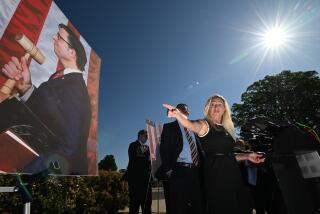A Survey of Why We Love to Hate Our Congressmen
- Share via
Folks responding to a 1981 Gallup poll on public confidence in institutions placed Congress way down between newspapers and organized labor. By 1989, even public schools and banks rated higher than federal lawmakers. And that was before the cost of the savings-and-loan crisis broke the $300-billion mark.
Why Americans love to hate their senators and congressmen is the subject of a summer “special issue” of The Public Interest that evaluates, attacks, defends and lampoons the legislative branch from a dozen perspectives.
The most vociferous critics of Congress in the publication, and in the world at large, tend to be conservative. But in “Congress-Bashing for Beginners,” Nelson W. Polsby points out that until the mid-1960s, liberals did most of the congressional tongue-lashing.
“Are memories so short that we do not recall these dear, departed days when Congress was the graveyard of the forward-looking proposals of liberal Presidents?” he asks.
Elsewhere in the issue, Norman Ornstein of the American Enterprise Institute ponders the mystery of how Democrats maintain their lock on Congress even as the country elects one Republican President after another.
In “Congressional Despots Then and Now,” Fred Barnes of the New Republic decides that tyrants still prowl the hallways of the House and Senate but “don’t have their former clout. Few members of Congress are terrified of them anymore.”
In the most cantankerous article, James L. Payne, director of Lytton Research and Analysis, argues that Congress has become an “autonarchy,” a “circular government by itself” in which lawmakers routinely present themselves as experts to each other, vested interests lobby incessantly for spending programs, and no one steps forward to oppose expenditures.
Payne tracked 14 hearings before various congressional appropriations committees at which 1,060 witnesses appeared; 63% were government employees and 33% were lobbyists testifying in support of a proposal.
“Hardly anyone appeared to make arguments against spending,” he found.
Payne concludes that such a lopsided bombardment of testimony amounts to congressional “brainwashing.”
REQUIRED READING
“The Roots of Muslim Rage” is the cover story in the September Atlantic Monthly. The cover illustration depicts a bearded man in a turban with U.S. flags reflected in his angry eyes.
But when he wrote the story Princeton University scholar Bernard Lewis was clueless that Iraq’s Saddam Hussein would invade Kuwait and then try to rally the Islamic world to win a holy war against the United States.
Even though it was submitted in May and put into print in June, the article offers insight into the crisis. Lewis traces the conflict back 14 centuries through “a long series of attacks and counterattacks, jihads and crusades, conquests and reconquests.” He argues that the longstanding tension between the Islamic world and the West “is no less than a clash of civilizations--the perhaps irrational but surely historic reaction of an ancient rival against our Judeo-Christian heritage, our secular present, and the worldwide expansion of both.
“It is crucially important,” he adds, “that we on our side should not be provoked into an equally historic but also equally irrational reaction against that rival.”
With luck, his conclusion, written before President Bush launched Desert Shield, will prove at least partially accurate.
“We should not exaggerate the dimensions of the problem,” he wrote in calmer times. “Certainly nowhere in the Muslim world, in the Middle East or elsewhere, has American policy suffered disasters or encountered problems comparable to those in Southeast Asia or Central America. There is no Cuba, no Vietnam in the Muslim world, and no place where American forces are involved as combatants or even as ‘advisers.’ ”
* Speaking of odd timing, the “fine print” section of the September Spy features excerpts from a recent and enlightening conversation, transcribed from Radio Baghdad, between several U.S. senators and Saddam Hussein himself.
“To their credit, these men, particularly Senators Alan Simpson (R-Wyo.) and Robert Dole (R-Kansas), managed to find something to bring them and the Iraqi president together,” Spy reports.
For example, Simpson reportedly confided to Hussein: “Democracy is a very irksome and confusing thing. I believe your problem is with the Western media, not with with the U.S. government. . . . The press is spoiled and conceited. All the journalists consider themselves brilliant political scientists. . . . My advice is that you allow those bastards to come here and see things for themselves.”
* One photograph focuses on blue sky, blue sea and snow-capped mountains from within the gooey black oil contained in a floating cleanup corral after the Exxon Valdez spill. Another shot features clouds of coal-based smoke pouring from a rubber plant in Copsa Mica, Romania, “the world’s most polluted town.” From cover to cover the September/October American Photo’s “special environmental issue” is loaded with remarkable images that answer the editors’ question: “What can a photograph do to save the environment?” The issue even includes a guide to “Eco-Etiquette for Photographers.”
* Have magazines taken over your home and threatened your domestic tranquility? Well, think twice before calling the recyclers’ SWAT team to forcibly remove the publications. Richard Thau says in the Aug. 13 Magazine Week that there’s money to be made in old magazines. If you had held on to your 1954 debut issue of Playboy (the one with Marilyn Monroe on the cover), for example, you might find someone willing to buy it for $600 to $1,200. Most old magazines, however, are worth considerably less: Issues from the 1930s, for instance, tend to fetch about $12.
More to Read
Get the L.A. Times Politics newsletter
Deeply reported insights into legislation, politics and policy from Sacramento, Washington and beyond. In your inbox twice per week.
You may occasionally receive promotional content from the Los Angeles Times.










